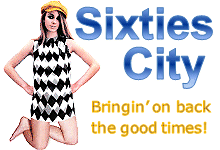

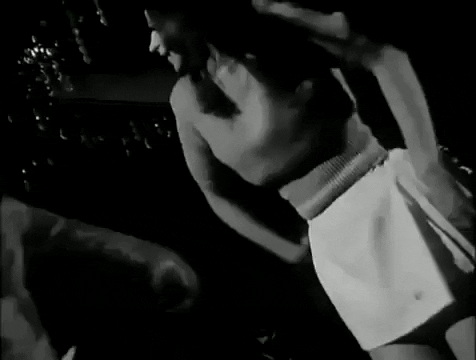
 |

|
 |
|
If
you can help improve this page by providing pictures, steps or instructions
on how any of the dances listed here were performed, or add to the names
list, please get in touch!
|
|
Dance
Craze A-Z List Count:
632 |
UK / US Sixties Dance Listing A - Z Dance Steps and Instructions Also see other site pages: 'The Birth of The Twist' Soho - The Swinging Sixties Ready Steady Go! |
| The
arrival of rock'n'roll brought a major change to the social art of dancing.
Although contact dancing with a partner was still as popular as always (naturally!),
variations and speed became more frantic and less formalised. Non-contact
dances and those that could be performed solo became ever more popular,
particularly with The Mods. The styles and crazes changed with rapid regularity,
in line with new records and the changes in musical styles and taste. The biggest and most enduring of these new dances was undeniably 'The Twist'. Pioneered in the States by Chubby Checker and a group called Joey Dee and the Starliters, it was huge to the point where national competitions were held. It found its way to British dance halls around 1961 with Chubby Checker's chart-topping record 'Let's Twist Again' and various follow-ups. In the USA instructions for doing 'The Twist' were enclosed, with every record sold, advising "Imagine you are stubbing out a cigarette with both feet whilst drying your back with a towel", which pretty well describes it. 'The Twist' was a song written and recorded in 1959 by Hank Ballard and his group The Midnighters, inspired by the way his backing singers moved as they sang. The original version was the 'B' side to 'Teardrops On Your Letter'. American DJ Dick Clark failed to talk Hank Ballard into performing the song on 'American Bandstand' so he persuaded his local Philadelphia record label, Cameo Parkway, to launch their own version of the song. For the recording session they used an unknown chicken plucker called Earnest Evans who was also an amateur song style impersonator. Before release, Dick Clark's wife suggested that Earnest adopt a stage name, maybe something like 'Fats Domino', so they substituted 'Chubby' for 'Fats', 'Checker' for 'Domino' and the rest, as they say, is history! No other dance craze really came close to it, despite the best efforts of the television pop show Ready Steady Go! which broadcasted its (almost) weekly 'new moves' section to a huge audience. Resident dancers on the show were Theresa Confrey and Patrick Kerr who both invented and demonstrated new dances alongside 'members of the public' (chosen specially during their visits to the 'Sabre' club). |
 |
The Cavern Club in Liverpool
had its own special dance almost forced upon it. Called 'The Cavern
Stomp', it consisted of holding hands with the person nearest you and
jerking backwards and forwards in an effort to avoid falling over. This
was just about all that was possible due to the overcrowded nature of
the venue! |
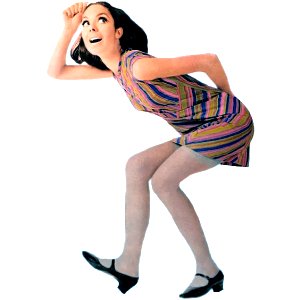 |
|
The
Frug
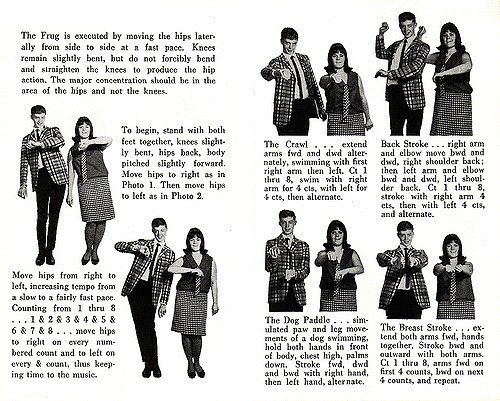 |
What's most important here is coordination. The Frug may be a little hard to 'get' - but it's one of the most popular, so must be worth the effort and, if you've ever managed to coordinate enough to pat your head and rub your stomach at the same time, you can feel confident about The Frug. Feet: Rest all your weight on your left foot - as if you're waiting for a bus - with your leg stiff. Let your right knee bend. Feet as close or far apart as you find most comfortable once you get into the movement. Body: Generally, forward. Hands: Waist high Basic Movement: Just keeping time with your right knee, bending and straightening as much as possible - as much as the rapid beat of the music will allow. Most people find they're most comfortable with their feet just a few inches apart, the right foot just a little more forward than the left. Styling: Alternate your hands, front and back. When your right hand is in front, your left hand is back, two beats each. For girls only - put your wrists, with the palms of your hands in, against your hips. For either of the above styles, you look to the left when the left hand is forward (two beats) and to the right when the right hand is forward (two beats). Once you do 'get it' you'll find that the over-all movement of The Frug comes from your rib cage - above the hips. Some variations are 'The Aloof', 'The Heavyweight' and 'The Big Finish' that can all be seen in 'Sweet Charity' - 'The Rich Man's Frug' |
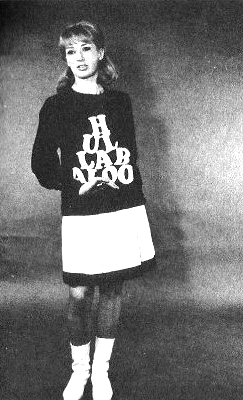 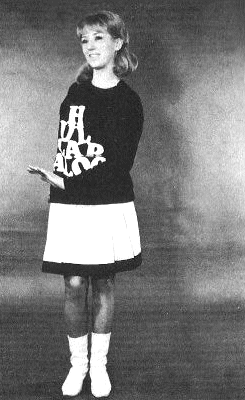 |
| The Bug A dance that is basically The Frug, with a plus: You and your partner are doing The Frug but one of you, say your partner, instead of the usual Frug hand motion, does a 'shooing' motion to the beat of the record - shooing a 'bug' away, to the left, to the right. Suddenly, the shooer 'throws it' (the bug) to you and goes back to the Frug hand movements, leaving it up to you to 'shoo' until you feel like throwing it back. Note: You can throw the bug to someone other than your partner - at least, if you're among friends! Also, you can use these hand movements with dances other than The Frug. |
 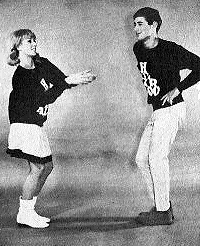 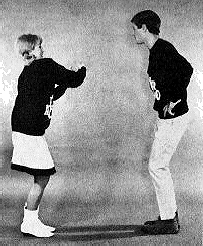 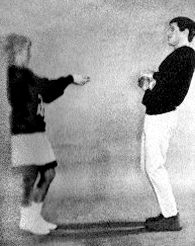 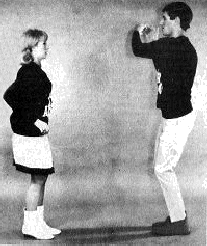 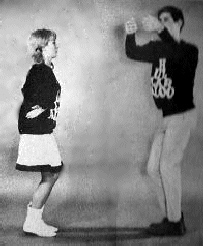 |
| The Waddle
/ The Wobble / The Watusi This dance may be done by a single couple facing one another. However, it is usually performed in a group. In the group form there are lines of dancers facing each other about a foot apart, with no hand contact. One line of boys, the other of girls. Both lines move in the same direction, the boys starting with the right foot and the girls with the left.The lines move in one direction for four counts, then in the opposite direction for four counts. Variations are performed mainly through changes in arm movements. For clarity, both partners are shown facing in the same direction. Usually, they face one another, the girl |
The
Tamoure Just in case you are wonderinghow to pronounce this very unusual name from the island of Tahiti, it's Tam-or-ay, rolling the 'r' a little. Basic Steps - boys and girls: Girls can use a hip swinging action if desired, taking small walking steps forward and back as the hips rotate. Stand with the feet almost together, relax knees to the point of being half bent, very nearly to sitting position. |
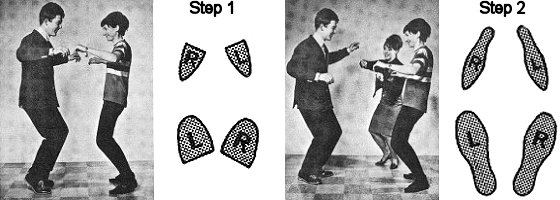 And 1, and 2, and 3 and four. On 'and', the heels are off the floor. On 1, 2, 3, 4 the heels touch the floor. |
|||
|
executing the counterpart of the boy's steps. Teenage fads had a tendency
to change from one part of the country to another, even from one part of a city to another. The names and the basic patterns may differ. This dance is presented as it was done in New York City where it was known by the above names. Basic Step: |
Raise
the arms so that elbows are about six or eight inches away from the body
with forearms pointed upwards. This position is maintained throughout the
following steps. 1. Raise heels off the floor, spreading knees outwards. 2. Close knees together, lower heels to the floor. Repeat these two movements, slowly first, then gradually pick up the pace, and counting: |
||||
| Count 1
(hold count 2). Begin by clapping hands together and stepping to the side with the right foot. Count 1 and hold count 2. |
 |
Count 5
(hold count 6). On count 5, step sidewards with the left foot and hold the count of 6. |
 |
||
| Count
'and'. On count 'and', cross the left foot behind the right foot. |
 |
Count
'and'. On count 'and', cross the right foot behind the left foot |
 |
||
| Count
3. On count 3, step to the right side with the right foot again. |
 |
Count
7. On count 7, step sidewards with the left foot. |
 |
||
| Count
4. On count 4, brush the left foot against the floor and kick forward, clapping hands at the same time. |
 |
Count
8. On count 8, brush the right foot against the floor and kick forward, clapping hands at the same time. Repeat 1 through 8. |
 |
||
| Watusi
Step Variation: Do the steps forward and back instead of sideways.
Woman: 1. Right foot forward 2. Left foot forward and left 3. Right foot forward and right 4. You end up with your feet apart - and clap your hands Man: 1. Left foot forward 2. Right foot forward and right 3. Left foot forward and left 4. You end up with your feet apart - and clap your hands Repeat the same pattern, always starting with the same foot. You can just keep going in one direction until you run out of space, or change direction whenever you wish. Watusi Hand Variations: 1. Popeye or Sightseer: Looking right, with your right hand over your eyes and your left on your hip; then looking left with your left hand over your eyes and your right on your hip, and repeat 2. Rowing the Boat: Hands reach forward and pull back the oars 3. Dean Martin: Figure this one out for yourselves....... 4. Dracula: Anyone, or anything, you can think of to pantomime |
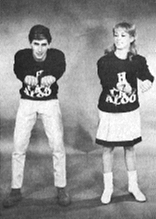 Rowing the Boat |
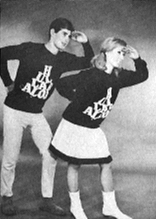 Popeye |
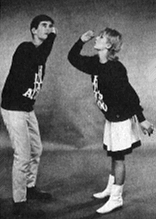 Dean Martin |
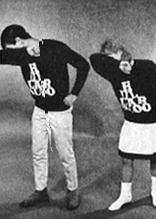 Dracula |
| The
Ginza Created for, and named after, a New York discotheque with Japanese decor, this was originally performed by girls in hanging cages but soon adopted by the patrons. The dance is basically a 'Monkey' variation: Hands: Extended, 'holding chopsticks' - use your imagination! Facing your partner, you maintain a 'Monkey' beat, but go down, bending at the knees. As you are going back up, your partner is going down, and vice versa. |
  |
| The
Mouse American TV star Soupy Sales' dance is another 'Monkey' variation. What makes it The Mouse'? Put your thumbs to your ears, wiggle your fingers, put your upper teeth over your lower lip and keep the beat with your knees. That's it! |
The
Bird Feet: A few inches apart - they don't move. Body: Bent forward, facing your partner, almost nose-to-nose. Hands: Keep them on your thighs. Basic Movement: Your head does it all. Move it forward and to the right, and back. Then forward to the left, and back. Keep repeating and hope that your partner is in time with you or it gets painful! |
The
Bostella The music for this is the Mexican Hat Dance. Your hands can go on your hips or over your head, while doing the 'hat dance' steps. You can hold one, or both, of your partner's hands, or neither, but it may be wise to 'anchor' yourself for the ending, which is the whole point - you all fall down! Black or dark clothing recommended..... |
| The
Slop Count: Step, tap - step, tap - walk, walk. Feet: Together Hands: Waist level Body: Straight 1. Step to the right with right foot 2. Bring left foot to right foot in a hard tap on the floor with the ball of the foot. 3. Step to the left with left foot 4. Bring right foot to left foot in a hard tap on the floor with the ball of the foot. 5. Step back with right foot 6. Step back with left foot (lean forward from the waist on the walk steps. Repeat. Variations: Bring the toe to the heel in steps 2 & 4 instead of side by side. You can also turn, as in.......... |
|||||
| The
Freddie A slightly manic dance, as you'd expect, 'invented' by Freddie and The Dreamers, who did it as they sang. On the dance floor, you do it facing your partner (you don't need to sing!) Count: An even 1-2-3-4 Body: Straight Feet: Together Hands: At your sides Basic Movement: Leaning your body side to side in one place and...... Woman: 1. Raise your right arm straight out to the right. At the same time, raise your right leg straight out to the right, leaning your body to the left so all your weight is on your left leg 2. Return to your original position 3. Do the same thing with your left arm and leg, putting your weight on your right leg 4. Return to your original position 5. Repeat from '1' Man: You and your partner can do this in the same direction, i.e. you are raising your left arm when she is raising her right, or you can do it in opposite directions. You can also do this back-to-back |
 |
| The
Bossa Nova This Brazilian dance is not one of the real discotheque dances, but is played a lot with them as a sort of interlude or break. The music you dance to is a cross between Samba and Rumba with the styling of both: the vertical motion of the Samba and the Cuban 'hip' motion of the Rumba. The tempo here is a little slower than that in the discotheque dances. The Bossa Nova is done smoothly and, unlike the other 'tap' steps in other dances, the tap here is a light one. |
It is also different from most of the discotheque dances in that you follow your partner in regular dance position. Remember that? Count: step-tap / step-tap / step-tap / step-tap. Feet: Together Movement: Basically, a shift of weight from one foot to the other, in a little back-and-forth and side-to-side pattern. |
Man: 1. Step forward with your left foot. 2. Tap with your right (toe). 3. Step back with your right foot. 4. Tap with your left (toe). 5. Step to the side with your left foot. 6. Tap with your right (toe). 7. Step to the side with your right foot. 8. Tap with your left. Repeat |
Woman: 1. Step forward with your right foot. 2. Tap with your left (toe). 3. Step forward with your left foot. 4. Tap with your right (toe). 5. Step to the side with your right foot. 6. Tap with your left (toe). 7. Step to the side with your left foot. 8. Tap with your right. Repeat |
Variation: A walk-around - The man keeps the 1 - 2 (step - tap) beat, side - to - side only. As he does the first left toe tap he lifts his left hand and the girl goes into a complete turn to the count of: 1-tap / 2-tap / 3-tap / 4-tap / 5-tap / 6-tap. On the count of six she should be back in position, facing partner. Then, back into the basic Bossa Nova. |
|
1.
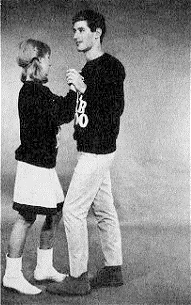 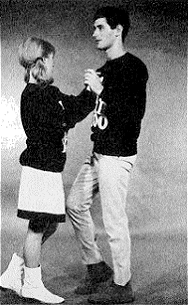
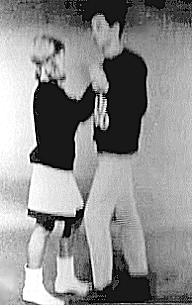 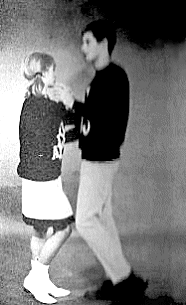
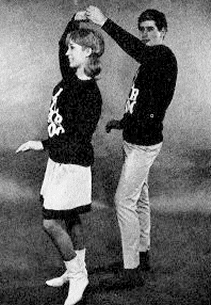 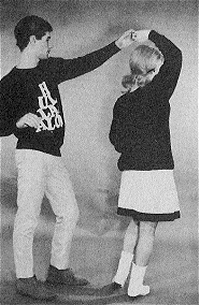
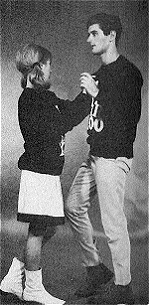 |
||||
| The
Loddy Lo The main feature of The Loddy Lo is the 'self hand hold'. To achieve this, simply place the left hand palm to right hand palm, fingers pointing to ceiling - tips of fingers almost at chin level, elbows held upwards, but towards the front of the body. This hand-hold should be maintained throughout, although hands together can raise or lower in any direction, up, down, left, right, circular or even zigzag-wise. The basic rocking movement can be danced continuously or, for the more advanced, the Loddy Skip or Shuffle can be included. The Loddy Lo can be danced with or without a partner. As in The Twist, individuals develop their own styling. Girls' and boys' steps are identical and can be danced side-by-side or facing each other. Loddy Lo Basic: 1. Using a 'rocking' movement, step forward on to left foot, then rock continuously backwards and forwards, transferring weight on to the right foot and left foot throughout. (A turn to the left can be made). 2. If a turn to the right is desired, step back on to the left foot and continue rocking as above. |
Loddy Skip: 1. Step on to the left foot, then take a small hop, raising the right knee upwards. 2. Step on to the right foot, then take a small hop, raising the left knee upwards. Repeat 1 and 2. Hand movements used on these four steps are: 1. Above the head 2. To the left 3. To the right 4. Above the head. Shuffle: Moving leftwards. 1. Take a small step to the side with the left foot. 2. Close right foot to left foot. Repeat 1 and 2 as often as desired. To move rightwards, step to the side with the right foot then close left foot to right foot. When moving left, hands circle to the left, and vice versa. The Loddy Lo can be danced to practically any rhythm, although both Joe Loss and Chubby Checker have made recordings of this same title. |
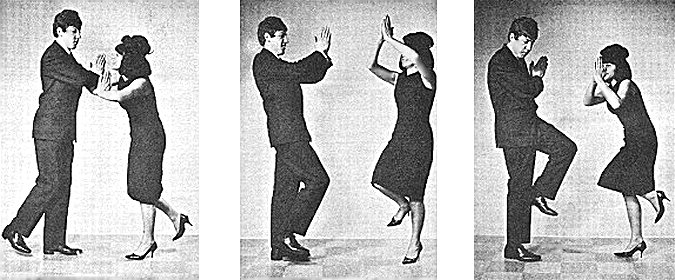  Basic Step 1 Skip, steps 1-3 Skip, steps 2-4 |
|
The
Blue-Beat
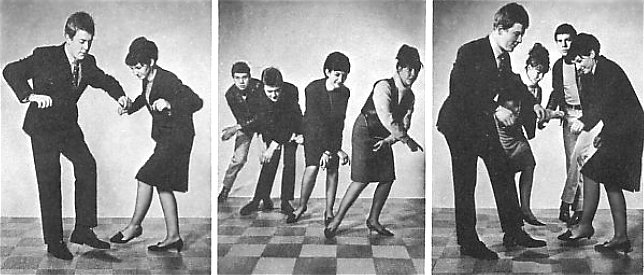
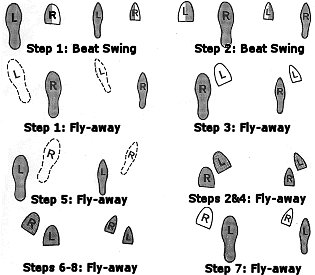 Fly-away step 1 Swing step 1 Fly-away (group) |
Basic Blue-Beat
Swing -
same steps for boy and girl
Stand with feet apart, hands at side of body 2 or 3 inches from side. 1. Swing weight over onto left foot, both knees bending over to the left, swinging arms across each other at the same time. 2. Swing weight over onto right foot, both knees bending over to the right, uncrossing arms and swinging them wide open away from body. Continue this swinging movement left and right, keeping time to the very definite background beat that you can hear in all 'blue-beat' music. Keep arm swing sharp and defined. Blue-Beat Fly-Away (can be danced before or after the basic swing) 1. Straighten right knee, raising left foot in sharp, small kick in front of right foot 2. Step onto left foot, lowering it in front of right foot 3-4. Transfer weight onto right foot, then left foot, in a rocking action. 5. Straighten left knee, raising right foot in sharp, small kick in front of left foot. 6. Step onto right foot, lowering it in front of left foot. 7-8. Transfer weight onto left foot, then right foot, in a rocking action. |
| The
Blues or Shake The 'Blues' or 'Shake' is very much a 'go as you please' affair, a complete change of body action from the side-to-side 'Twist'. It was brought about originally by the music of The Dave Clark Five, a beat so strong and vibrant that it seems every nerve in the human frame tries to shake itself loose at the sound of the music. So, to give you some idea how to achieve this movement, put a Dave Clark disc on the turntable and you're all set to go. Starting from a feet together position (boys and girls exactly the same), place the right foot forward and slightly to the side. The knee should be bent and the body, from the waist upwards, should be bent over the right foot. The left leg must be kept straight with a feeling of pushing the knee cap back as far as possible. |
 |
The left hip should also have the feeling of being pushed out to the left. The arms are held straight, about eight or ten inches from the sides of the body (or, later on, clasped lightly behind the back). Most of the weight is on the left foot. Basic Steps: 1. Raise right heel off the floor and allow left knee to bend slightly. 2. Lower right heel to floor, pushing left knee sharply backwards. Count about two movements (and-one) - the 'and' is when the heel is off the floor, the 'one' when it lowers. Using these two movements throughout, count 'and-one', 'and-two', 'and-three', 'and-four', moving arms over to the left in four sharp actions, then over to the right in the same way. When your left leg tires, swivel weight on to the right foot, turning slightly left and proceed as before, this time raising and lowering the left heel off the floor in sharp taps. When this has been mastered, introduce your own hand and arm movements, at the same time allowing hands, hips, shoulders and head to shake. It will take a little practice so don't give up too easily. You really need the music to get the 'feel' of this one! |
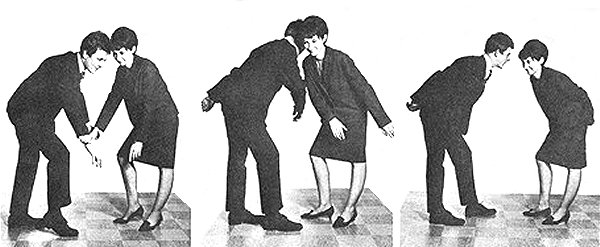 Step 1 Step 2 Philip Blues |
 |
|
| The
Basic Continental Madison Step (1.5
bars) It's six beats and it goes like this. Step; close; step; tap; tap; tap. Stand slightly sideways with your left shoulder to the front. 1. Step left foot to the side. 2. Close right foot to left foot without weight and clap. 3. Step back onto right foot to place. 4. Cross left foot in front of right foot and tap. 5. Uncross left foot and tap. 6. Cross left foot in front and tap. On the clap, reach forward with both arms. On the taps raise the hands to shoulder level and wave from side to side. |
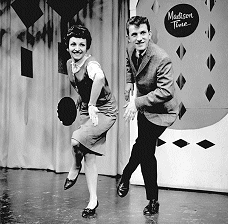 |
Madison
Time Typical music is 'The Madison Time' by The Ray Bryant Combo, available on various CD compilations. The tune is in regular 4/4 time. The dance consists of a basic step and a series of figures. Each figure occupies a fixed number of beats, but they are all different. Don't expect the figures to start on the first beat of a bar or at the beginning of a phrase as they go all across the music. The basic step occupies 6 beats or one and a half bars, so the step weaves pleasantly in and out of the tune. Always complete the basic step you're doing, then go straight into the figure, whatever the tune may be doing. Madison Dance Instructional Video |
| The
Basic British Madison Step (1.5
bars) Note: There are two basic Madison steps, the Continental and the British. The standardised British version, danced to Twist or Jive music, is very similar: Step 1: Step forward on left foot. Rhythm count 1 or Quick. Step 2: Close right foot to left foot without weight. Rhythm count 2 or Quick. Step 3: Use right foot again and step back on it. Rhythm count 3 or Quick. Step 4: Close left foot to right foot without weight. Rhythm count 4 or Quick. Step 5: Point left toe forward without weight. Rhythm count 5 or Quick. Step 6: Close left foot to right foot without weight. Rhythm count 6 or Quick. Now step forward on left foot and repeat from step 1. |
|
The
Stomp
Step 1 - Feet slightly apart, straight ahead. Step 2 - Partners stand about one and a half feet apart, facing each other. Step 3 - Snap your fingers. Step 4 - Slide your right foot back, then forward stomp, do it again. Step 5 - Slide your left foot back, then forward stomp, do it again. Step 6 - Repeat. |
 |
 |
 |
 |
 |
 |
|
The
basic steps of he Stomp are
definite arm and leg movements |
Now
listen to that beat, remembering the foot movements are similar to the
old skip jive
|
Swing
your arms from side to side, keeping in time with the music
|
Kick
your leg to the left while swinging your hands to the right
|
Kick
your right leg to the right while
swinging your hands to the left |
Easy!
- You can use your own
variations with the basic steps |
Cleveland Box (4 bars) This is a box step, but it's a bit more complicated than the 4 step box used by line dancers and The Shadows. Imagine a compass rose on the floor about 18 inches across. You start, not in the centre, but at the S mark, and visit four points around the circle, as follows: Step LF to SW. Close RF. Step LF to NW. Step RF to NE. Close LF. Step RF to SE. Step LF to SW. Close RF. Each step is two beats. Where's the pattern in that, you may ask. Well, you need to visit each of the four points by stepping onto each then closing with the free foot. However, in some cases a close will put you on the wrong foot for the next side step. You therefore omit the close when it would trip you up on the next step. Try it and see. Whilst you're doing this you bend forward from the waist and revolve the hands rapidly around each other. When you close with the feet you don't simply bring the feet together. You bring your free foot directly behind the standing foot and spring on to it, knocking away the other foot. On every close, you stand upright, then bend forward for the next step. Needs a bit of practice, but don't ask me to demonstrate!! Basketball with the Wilt Chamberlain Hook (3 bars) Chasse to the left dribbling the ball. Jump to shoot the hoop turning anticlockwise (2 beats). Jump back clockwise to front (2 beats). Chasse back to the right, calling out the score. ("Two points"). Jackie Gleason (2.5 bars) Chasse to the left. Throw R leg out to the front, then swing it back in front of L leg. Launch forward on to RF with arms outstretched (2 beats). ("Awaaaaay we go"). Step L, Step back R to place. Birdland (6.5 bars) Totally freeform. Walk around doing various bird impressions as you wish. Two Up, Two Back, Double Cross and Freeze (4.5 bars) Chasse to the left and right. Walk forward crossing free leg in front (2 beats per step). Freeze. |
Huggy
Bug
|
Count: A simple 1 - 2, 1 - 2, step-tap, step-tap. Feet: Together. Body: Straight. Hands: Crossed in front of you at waist level. Basic Movement: 1. Step to the right, swinging hands out and bending way over from the waist. 2. Bring your left foot in back of the right in a tap, bending your knees and shifting your body weight backward. Your hands come back in front of you, crossed. Repeat to the left side: 1. Step to the left, swinging hands out and bending way over from the waist. 2. Bring your right foot in back of the left in a tap, bending your knees and shifting your body weight backward. Your hands come back in front of you, crossed. |
 |
Variation 1: (also see below) Hands can be as if you were rowing a boat - push forward on the oars when you're bending forward on the first count. Pull backwards on the oars - until your hands are stretched out behind you - on the second (tap) count. Variation 2: Hands can be used as if climbing a rope. Frug Variation for use with The Ska: You can go nicely from The Ska into The Frug, moving your right foot forward, putting your weight on your right and keeping the rhythm with your knee. Then..... Washing clothes: Best done to a four count. The left hand is holding a washboard and the right is scrubbing. When you shift your weight to your left leg and keep time with your right knee, let your right hand hold the washboard and your left hand scrub. |
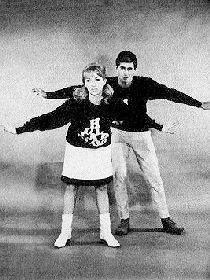 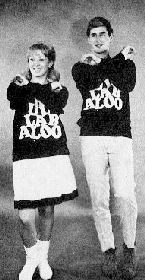 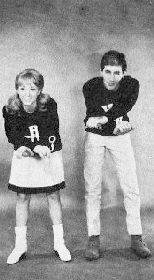 |


|
The
Hand Jive
Another dance that was born in the Fifties but kept coming back to haunt us. This is usually performed to fast rock'n'roll music so each movement in this sequence needs to be done in rapid succession - keeping in time to the music - the faster the better! It can be done while sitting down or standing up and can get you quite confused and out of sequence after a while so, although simple, needs to be well-practised, especially as you increase the number of variant movements. The most basic form of the dance is as follows.: Begin the dance by slapping your open palms on the tops of your thighs twice. Clap your hands twice. Put your hands out with the palms facing down and wave the right hand over the top of the left twice then switch hands and wave the left over the right twice. Make a fist with each hand with the thumbs over the fingers and facing each other. Take the right fist and tap the top of the left fist twice then switch hands and tap the right fist with the left fist twice. Cup the left elbow in your right hand and make a circle in the air with your left index finger. Repeat for the other arm. Flip your thumbs up and make a hitchhiking gesture with your right hand, jerking the thumb over your right shoulder twice. Do the same thing with your left hand then repeat from the start for the duration of the song. |
|
The
Bug
1. Form a circle 2. Get in the circle 3. Combat the bug 4. Start scratchin' 5. Pass the bug 6. Repeat steps 1-5 Stomp right forward, stomp left forward. Heel, hook, heel, together. Heel split, hitch left. Charleston kicks. Left step forward, kick right, right together, stomp left. Point, sway, step, sway. Vine left with one-quarter counter-clockwise turn, hitch right knee. Walk back, stomp right two times. Keep going! An enjoyable 'free-form' dance that requires little dancing talent but some degree of imagination. |
Well, yes... steps 3 and 5 are a bit of a mystery to me as well.... so thanks to 'Ed' for some clarification. He writes: The dance begins by forming a circle. Everyone in the circle dances in place. One person gets into the centre of the circle and begins dancing, swatting and scratching like they have a bug in their clothes. The dancer in the circle then 'catches the bug' and 'throws' it onto someone else who is in the circle. This person moves into the centre of the circle and the first dancer moves back to the circle. It's a lot of fun, but the song generally needs to be played several times to make it really enjoyable as 'The Bug' is only a 2 minute 15 second song. |
The
Zulu Stamp Stamp with the right foot. Lift right foot Jump onto the right foot Jump onto left foot and back onto right foot Stamp with the left foot. Lift left foot Jump onto the left foot Jump onto right foot and back onto left foot Repeat Arm Movement: At start of Stamp raise both arms above your head. Clench Fists. As you stamp, bring arms sharply down to waist level. During rest of Stamp alternate arms and legs as in normal walking or running. |
The Roach
Thanks again to 'Ed' who writes: "You can get a good feel for this dance by watching John Water's 'Hairspray' - the original film from the late 80s (The Bug is also part of this film). I'm unsure of the entire nature of the dance, but I do know that it starts with a line. There is a stomping, squishing motion with the feet and an arm movement like you are 'fumigating' to kill a roach. The lyrics to the song say "You stomp, step, skip, 2,3,4,5,6,7, you stomp, step, skip, 2,3,4,5,6,7, you stomp, step, skip, 2,3,4,5,6,7, you stomp, step, skip, 2,3,4,5,6,7, squish, squash, kill that roach." This suggests that it may have been a box-style dance since there are so many steps. Not sure that this helps much..." |
| The
Wrangler Stretch 1. Hands reach above head - 2 counts 2. Swing arms left and pull twice as if pulling on a rope - 2 counts, 1 each pull 3. Swing arms right and repeat 'pull' as in 2 4. Bend your knees and stretch up with hands to waist as if pulling on jeans - 2 counts 5. Repeat steps 1 through 4 6. Do steps 1, 2, 3, then back to 2 7. Bend your knees - arms down at knees - palms down, fingers intertwined, gradually stretch body and arms up for 4 counts (on 4th count hands are above head in full stretch) 8. While hands are above head, shake hips - 4 counts |
  |
| The Buzzard
In which you ... imitate a Buzzard! Feet: A few inches apart; they stay in place Arms: Outstretched, of course - they're your wings Body: Bent from the waist, head forward Movement: Bending one knee, then the other, alternately, you wave your arms gracefully. Up and down, up and down, sideways - in flight. There's a sort of hula feeling to the arm motion. |
 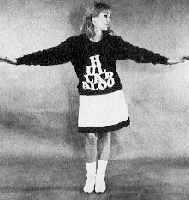 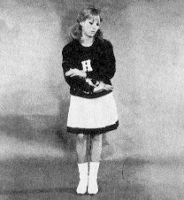 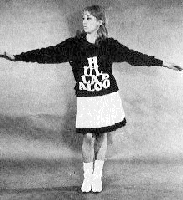 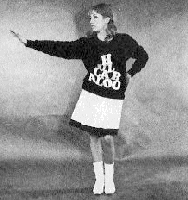 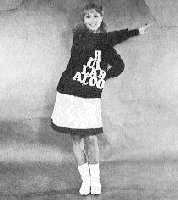 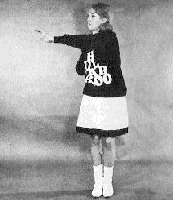 |
|
|
All
Original Material Copyright SixtiesCity
Other individual owner copyrights may apply to Photographic Images |